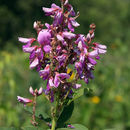en
names in breadcrumbs


Desmodium canadense is a species of flowering plant in the legume family, Fabaceae. It is native to eastern North America. Its common names include showy tick-trefoil, Canadian tick-trefoil,[1] and Canada tickclover.[2]
The plant is a perennial herb and grows in woods, prairies, and disturbed habitat, such as roadsides. It is cultivated as an ornamental plant. It is a larval host plant for butterflies such as the eastern tailed-blue, silver-spotted skipper, and hoary edge. The plant attracts butterflies and hummingbirds.[3] Flowers are pea-shaped, pink to purple in color, and bloom between July and September.[4]
Desmodium canadense is a species of flowering plant in the legume family, Fabaceae. It is native to eastern North America. Its common names include showy tick-trefoil, Canadian tick-trefoil, and Canada tickclover.
The plant is a perennial herb and grows in woods, prairies, and disturbed habitat, such as roadsides. It is cultivated as an ornamental plant. It is a larval host plant for butterflies such as the eastern tailed-blue, silver-spotted skipper, and hoary edge. The plant attracts butterflies and hummingbirds. Flowers are pea-shaped, pink to purple in color, and bloom between July and September.